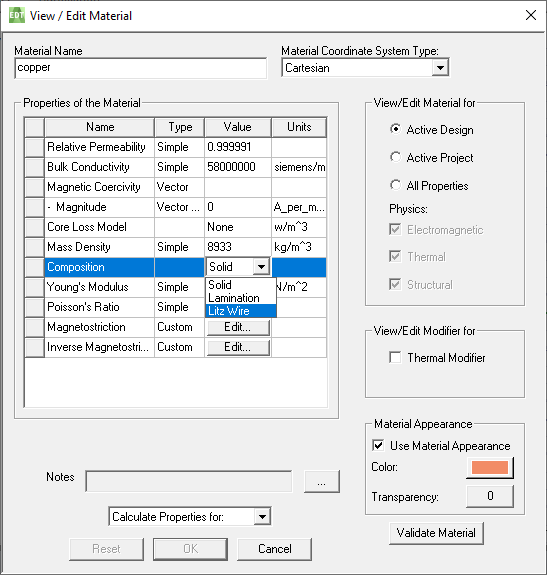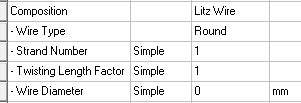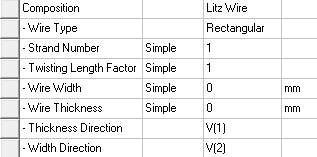Litz Wire Modeling
Litz wire is a multi-strand wire or cable whose primary benefit is in reducing AC losses in high frequency windings. It consists of many thin, individually insulated, wire strands, which are twisted or woven together in carefully prescribed patterns. The multiple strand construction of Litz wire allows current to divide uniformly between strands, thus reducing skin effect and proximity effect losses.
Some basic assumptions for applying this modeling approach are:
- Each Litz wire strand is insulated individually.
- Each strand is continuously and perfectly transposed so that every strand occupies every location in the cross-sectional area of the bundle over the lay length.
-
The largest dimension of strands (for example, diameter or thickness) is smaller than the skin depth d for the strand’s material.

Lizt wire modeling allows you to specify the wire type, number of strands, and various other parameters that define the shape of the Litz wire bundle.

When Litz Wire is selected, Wire Type is displayed under Composition. There are three options Round, Square, and Rectangular, for drop-down menu Wire Type. These are the three possible shapes for a Litz wire.

If Round (the default) is selected, Strand Number, Twisting Length Factor, and Wire Diameter are displayed. Default values are as shown below. Strand Number is the integer value of the number of strands in the wire bundle. Twisting Length Factor is the ratio of the twisted-strand length to the bundle length. Wire Diameter is a real number that defines the diameter of a single wire in the wire bundle. You can also select the desired unit of measure.

If Square is selected for Wire Type, Strand Number, Twisting Length Factor, and Wire Width are displayed. Default values are as shown below. Strand Number is the integer value of the number of strands in the wire bundle. Twisting Length Factor is the ratio of the twisted-strand length to the bundle length. Wire Width is a real number that defines the width of a single wire in the wire bundle. You can also select the desired unit of measure.

If Rectangular is selected for Wire Type, the properties Strand Number, Twisting Length Factor, Wire Width, Wire Thickness, Thickness Direction, and Width Direction will be displayed. Twisting Length Factor is the ratio of the twisted-strand length to the bundle length. Wire Width is a real number that defines the width of a single wire in the wire bundle. Default values are as shown below. For thickness direction and width direction The drop-down menus include three options: V(1), V(2) and V(3), representing x, y, and z directions, respectively, for the Cartesian Material Coordinate System Type; and r, θ, z directions, respectively, for the Cylindrical Material Coordinate System Type.

For inner/outer core types, the armature ac or dc windings inside core slots for large capacity machines rotating around z-axis usually have coils with wire thickness in r direction, and width in θ direction or, rarely, have coils with wire thickness in θ direction, and width in r direction.
For axial-flux core types, the armature ac or dc windings inside core slots of large capacity machines rotating in z-axis usually have coils with wire thickness in z direction, and width in θ direction, or rarely have coils with wire thickness in θ direction, and width in z direction.
The total loss from the Litz wire model (including DC loss and AC loss) is applied for thermal coupling. The effect of temperature on Litz wire loss calculation is taken into account in Maxwell by setting a thermal modifier for the bulk conductivity material property.
